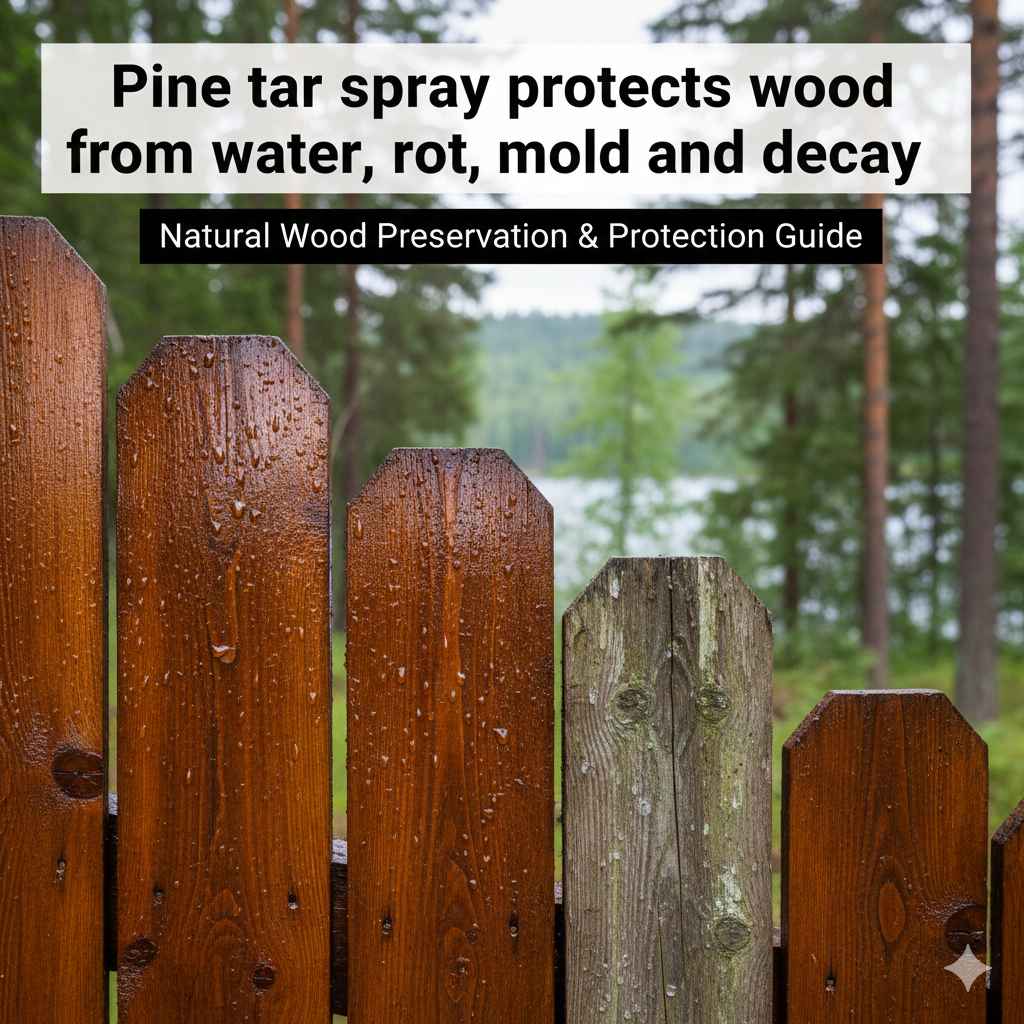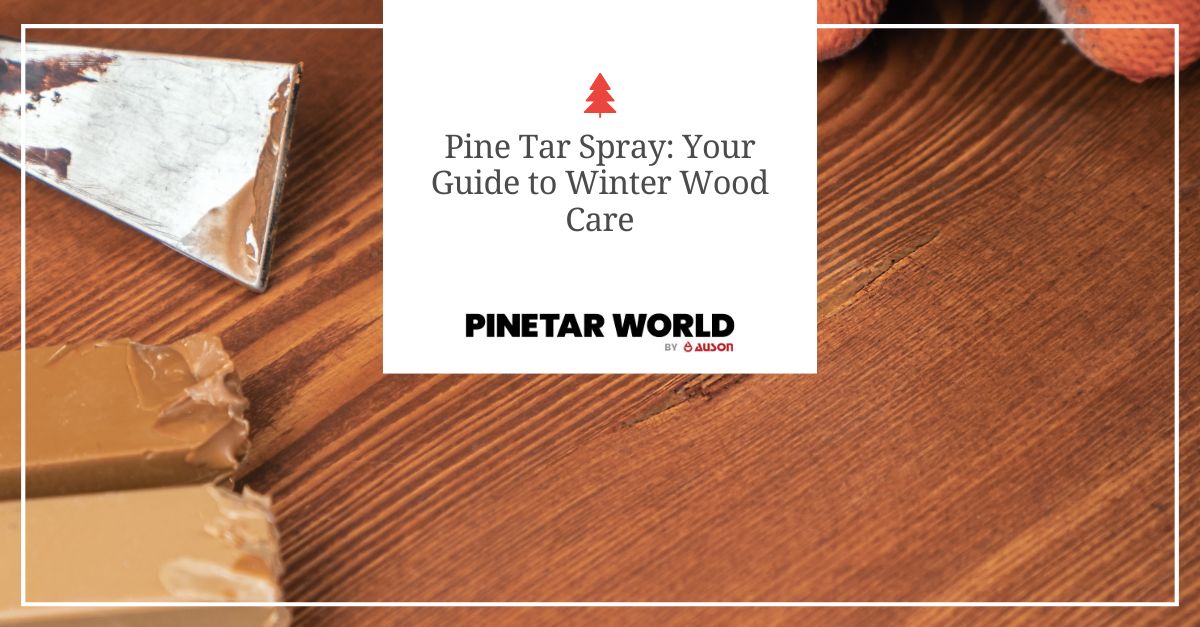Winter brings cozy nights and festive cheer, but it also brings harsh weather that can take a toll on your outdoor wood surfaces. Heavy rain, snow, and persistent humidity can lead to rot, mold, and algae, compromising the beauty and integrity of your decks, fences, and furniture. Protecting your wood before the wet season arrives is essential, and natural pine tar spray offers an effective solution.
This guide will walk you through how to use natural pine tar spray to shield your wood from the damaging effects of winter and rainy weather. We’ll cover everything from planning your application to best practices for applying it in colder climates, ensuring your wood stays healthy and looks great for years to come.

Planning Your Natural Pine Tar Application
Timing is everything when it comes to wood protection. Applying natural pine tar spray before the wet season begins is crucial for achieving the best results. The goal is to give the treatment ample time to penetrate the wood and cure properly, creating a durable, water-resistant barrier.
When to Apply
Aim to treat your wood during a dry spell in late summer or early fall. Check the weather forecast and look for a period of at least a few days without rain. Ideal conditions for application are:
- Dry Surfaces: The wood must be completely dry. Any moisture trapped underneath the pine tar can lead to mold and prevent the oil from absorbing correctly.
- Mild Temperatures: Apply the spray when temperatures are consistently above 50°F (10°C). Colder weather can thicken the pine tar, making it more difficult to spray and absorb evenly.
- Low Humidity: High humidity slows down the drying process. A dry, clear day is your best bet for a smooth application and effective curing.
By planning ahead, you ensure the pine tar has enough time to form a robust shield that will stand up to the impending rain and snow.
How Pine Tar Spray Performs in Harsh Weather
Pine tar has been used for centuries as a wood preservative, and for good reason. Its natural properties make it exceptionally resilient against the challenges of wet and cold climates. When applied correctly, pine tar spray provides superior protection by creating a breathable yet water-repellent layer.
Protection Against Heavy Rain
Pine tar is naturally hydrophobic, meaning it repels water. When rain hits a treated surface, it beads up and runs off instead of soaking into the wood fibers. This prevents the swelling, cracking, and warping that often occur when wood is repeatedly saturated. Unlike some synthetic sealants that can trap moisture, pine tar allows the wood to breathe, letting any internal moisture escape and preventing rot from the inside out.
Resilience in Snow and Ice
Snow and ice can be particularly damaging. As snow melts, the water seeps into untreated wood. When temperatures drop again, this water freezes and expands, causing cracks and structural damage. A surface treated with pine tar spray acts as a barrier, preventing this initial water absorption. The protective layer keeps melting snow from penetrating the wood, effectively safeguarding it from the freeze-thaw cycle.
Combating High Humidity
Constant dampness and high humidity create the perfect breeding ground for mold, mildew, and algae. Pine tar contains natural resins and terpenes that have antiseptic properties, actively inhibiting the growth of these unwanted fungi. This means your wood not only stays dry but also remains clean and free from the discoloration and decay associated with mold and mildew.

Applying Pine Tar Spray: The Do’s and Don’ts
Applying pine tar spray in colder or wetter climates requires a bit more care than in ideal conditions. Following these guidelines will help you achieve a professional and long-lasting finish.
DO:
- Prepare the Surface Thoroughly: Before you start, make sure the wood is clean and completely dry. Remove any old paint, dirt, or mildew. For older wood, a light sanding can help open up the pores and improve absorption.
- Wait for a Dry Spell: As mentioned, applying the spray during a clear, dry period is essential. Even if the temperature is low, a dry surface is non-negotiable.
- Apply Thin, Even Coats: It’s better to apply two thin coats than one thick one. A thin coat will penetrate the wood more effectively and dry faster. Allow the first coat to become touch-dry before applying the second.
- Warm the Product if Necessary: If you’re working in cooler temperatures, the pine tar may thicken. You can gently warm the can by placing it in a bucket of warm water to improve the spray consistency. Never use an open flame to heat the can.
- Wipe Away Excess: After about 30-60 minutes, check the surface for any pine tar that hasn’t been absorbed. Use a clean, lint-free cloth to wipe away any excess to prevent a sticky finish.
DON’T:
- Don’t Apply to Wet or Damp Wood: This is the most critical rule. Applying pine tar to a damp surface will trap moisture, leading to rot and a failed application.
- Don’t Apply in Direct, Intense Sunlight: While you need a dry day, applying the spray in the scorching sun can cause it to dry too quickly on the surface without proper penetration. An overcast, mild day is ideal.
- Don’t Rush the Curing Process: Allow plenty of time for the pine tar to cure fully. This can take anywhere from a few days to a week, depending on the temperature and humidity. Avoid exposing the surface to heavy moisture during this time.
- Don’t Forget Your Safety Gear: Always wear gloves, safety glasses, and a mask when working with pine tar spray to protect your skin, eyes, and respiratory system.
Protect Your Wood for the Long Haul
Protecting your outdoor wood from the harsh realities of winter and rainy seasons doesn’t have to be a difficult task. With its natural, time-tested properties, pine tar spray offers a reliable way to preserve the life and beauty of your wooden surfaces. By planning your application, understanding how it holds up in severe weather, and following proper application techniques, you can provide your wood with a durable shield that lasts.
We offer a wide range of wood protection products that provide your wooden surface with excellent protection. When you treat wood with one of our Pine Tars, you are infusing it with the substances naturally used by the wood itself to combat attacks from algae, mold, and fungus. Explore our products today to find the perfect solution for your needs.


